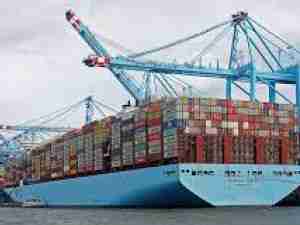Red Sea attacks impact market sentiment of shippers and exporters in Asia
- From negative sentiment to historic high values of xCPSI, market sentiment reverses in favour of price hikes in coming weeks
- Blank sailings, capacity reductions and network resetting- carrier strategies for Chinese New Year
- Equipment shortages from main liners will start to reflect in market: Container xChange customer, an exporter from India affirms
- “Container factories are operating at full capacity until March, with a surge in demand” an exporter from China confirms
Against the backdrop of escalating tensions in Yemen, the Red Sea has become a focal point of concern for international trade.
The Houthi attacks continue unabated. In the past week, we witnessed the most intricate series of attacks to date. Fortunately, the military presence in the region, led by the Americans and the United Kingdom, has proven effective in preventing the missiles and drones from reaching their intended targets. Noted Christian Roeloffs, CEO of Container xChange.
“This is a nightmare situation for shippers and exporters as freight rates, container prices and insurance costs have escalated. The impact has been significantly deterrent for container vessels since last month, 70-80% of container traffic has been rerouted, especially the larger carriers.” Roeloffs added.
Pre and Post-Chinese New Year Implications
"As Chinese New Year approaches amid ongoing disruptions in the Red Sea, we anticipate a tightening of container availability and vessel space in the pre-Chinese New Year phase. The rerouting via the Cape of Good Hope adds complexity to the situation. We expect freight rates to remain elevated, and supply chain managers will need to navigate ongoing schedule disruptions.
Looking beyond Chinese New Year, we project blank sailings and capacity reduction by carriers. The industry is witnessing a focused effort on resetting networks, leading to tightening of container availability and vessel space. While high freight rates and increased costs pose midterm challenges, our analysis indicates that these disruptions are not likely to be long-term. Rate reductions are anticipated on the horizon due to the structural overcapacity resulting from a severe market imbalance." - Christian Roeloffs, CEO of Container xChange
Global Impact: European Delays and Varied Effects Across the East
The Port of Eilat, Israel’s toehold on the Red Sea, has seen an 85% drop in shipping activity, its chief executive told Reuters last month.
The impact of disruptions in the Red Sea is reverberating in Europe, causing delays in shipments. Nevertheless, the persistent supply-demand imbalance has provided a cushion to the shockwaves so far and the rates have not skyrocketed yet to the post COVID, pent up demand levels.
“The impact has been distributed across the Far East. The container prices are escalating at a staggering rate, rising by 750 USD in less than two weeks.” Informed a customer from China.
The freight rates, for instance, from China to Europe are up by 282% from $1243 as on 1st December 2024 to $4757 in the week of 12 January 2023 (Source: Freightos).
Regional Insights: India's Uncertainty and China's Market Dynamics
“There is a lot of uncertainty and lack of demand ex-India right now. The effect of red sea is still to be determined in more tangible terms in the Indian market.” An exporter of containerised freight from India told Container xChange.
Another customer of Container xChange, a containerised freight exporter from India said, “Ocean freight costs across the ISC region is increasing drastically. Also, there is enough supply of containers in the region and there is no shortage of SOCs (Shippers owned containers) observed so far due to the Red Sea situation in this region. In the coming days, equipment shortages from main liners will start to reflect in market. All the big liners like the CMA CGM, MSC, Maersk and Hapag Lloyd have suspended operations through the Red Sea and hence, this will impact the SOC market positively. The pickup charges for shipper owned containers will start to increase in the coming weeks.”
While the effects in India have not yet prominently surfaced, the impact of the Red Sea situation is rather glaring in China.
"The current situation in the container industry reflects a highly competitive and rapidly evolving market. Container factories are operating at full capacity until March, with a surge in demand indicating the intensity of the current situation. The preference for brand new units highlights the market's anticipation of a prolonged scenario. The heightened demand has led to increased costs across leasing and trading, as suppliers seek quick returns by selling out their units. This has a cascading effect, with leasing suppliers adjusting prices due to rising trading costs, resulting in an overall inflation of prices.”
“The scarcity of units, particularly in the China to Russia and Europe routes, has intensified, leading to exorbitant prices. For instance, some suppliers are quoting $1600 USD for Ningbo to Moscow and over $1300 USD for China to Poland. While the US market has felt the impact, it's not as pronounced.”
“Intriguingly, entities focused on trading and supplying, such as local depots and trading companies, are strategically limiting sales quantities to 10 units per buyer. This approach stems from the belief that there is room for further price increases. Additionally, these depots face challenges in renewing their stock, as they are unable to obtain CW units from shipping lines. Consequently, stock levels are constrained.”
“The current landscape has also given rise to opportunistic sellers aiming to capitalize on the situation. Notably, sellers are prioritizing profits over traditional cost calculations, leading to uniform pricing in different locations. For instance, 40HC cargo-worthy unit prices remain same in Shanghai and Ningbo, deviating from the norm where Ningbo typically commands a higher price due to lower unit releases by shipping lines. Sellers are presently driven more by profit considerations than a comprehensive cost-benefit analysis, to benefit from the disruption.” Added the customer from China.
Market Sentiment Shift: Container Price Sentiment Index (xCPSI) Analysis
The Container Price Sentiment Index (xCPSI) serves as a valuable metric for assessing the prevailing market sentiments among supply chain professionals on the anticipated trajectory of container prices in the upcoming weeks. In the first quarter of 2023, the index values were in the range of -6 to -11, indicating a prevailing sentiment that the majority expected a decline in container prices during that period.
However, the landscape has witnessed a remarkable shift if compared on a year on year, month on month basis. As of January, the xCPSI values have surged to historic highs, ranging between 67-71. This substantial increase signifies a complete reversal in sentiment, with the majority of supply chain professionals now anticipating a notable upswing in container prices.
The scale values were fluctuating within the moderate range of 25-40 in the month of December, on a 100-point scale.
This significant escalation in market expectations regarding an imminent increase in container prices is a clear indicator of the industry's perception of how the Red Sea crisis is poised to impact container pricing dynamics in the foreseeable future. The heightened values on the xCPSI underscore a shared anticipation among supply chain professionals that the unfolding events in the Red Sea will likely exert upward pressure on container prices in the coming weeks.
Industry's Way Forward: Overcapacity, Ever Given Comparison, and Potential Challenges
“The freight rates are tripled since roughly a month ago, and the container prices are also expected to rise further in the short to midterm. The anticipated impact is significant.” Added Roeloffs.
“However, it's crucial to remember that our supply chains currently hold a surplus capacity of over 6 million TEUs, accumulated over the last two years due to a demand deficit. This excess capacity acts as a vital cushion to absorb potential shockwaves in the supply chain.”
“The degree of impact hinges on the duration of the Red Sea crisis. Should it persist for an extended period, and the excess capacity continues to be absorbed, we could potentially face serious challenges. Drawing a comparison to the Ever Given situation, where disruption occurred during a period of extreme difficulty in securing capacity and historic peak demand, rates skyrocketed to 10 times pre-pandemic levels. While we aren't currently at those historic highs, the recent rate surge is noticeable when viewed in the short term.”
The ongoing attacks by Houthi rebels, utilizing advanced weaponry is disrupting vital shipping routes, compelling shipping companies to reassess their operational strategies. The increased risk of hijackings and attacks not only endangers the safety of vessels and their crews but also triggers a domino effect on trade, leading to rerouting, heightened insurance costs, and delays.










